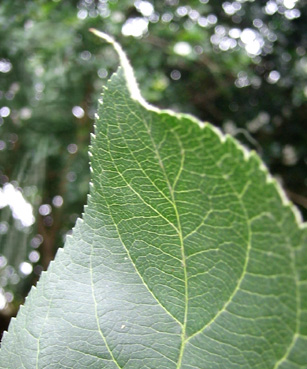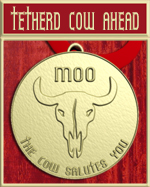
This is a leaf from a small plant in a pot in my backyard. It’s a tree. An apple tree in fact, and not just any apple tree. It’s an identical copy of perhaps the most famous apple tree in the history of humankind (I exclude mythical apple trees).
Let me tell you its story.
My friend Rod is a cider maker. In Australia it’s pretty hard to make good cider unless you grow your own apples, because cider is not just made from your average garden-variety apple tree. As a consequence, Rod has become fairly knowedgeable about apple trees, and especially interested in apple trees that might have a little bit of heritage.
Some years ago, Rod’s partner Michelle was in Parkes, in western NSW, on holiday with their children. Parkes is the home of one of Australia’s most famous scientific landmarks, the Parkes Radio Telescope,* which was a stop on their itinerary. While they were there, Michelle noticed an old apple tree in the grounds. A small plaque on the neglected tree told visitors that it was a descendant of the tree under which Isaac Newton sat while formulating his hypotheses on the nature of the force of gravity. Rod travelled to Parkes and asked the management at the telescope if he might take some cuttings. It worked out well – the old tree got a much-needed prune, and Rod got a number of cuttings, or scions.
Rod tells me that his research has uncovered the information that the variety of the tree is called ‘Flower of Kent’ and the original tree was growing in Newton’s mother’s garden at Woolsthorpe Manor, near Grantham in Lincolnshire. Newton had gone there to escape the plague which was rife in London at the time, and stayed there from 1665-1666 while he was consolidating his ideas on gravitation.
Apple trees are usually propagated clonally, that is, cuttings from one tree are grafted onto a sturdy rootstock to grow into maturity. This means that the descendants of the Newton tree are genetically identical to their parent tree. Clones of the Newton tree have been circulated to various scientific institutions across the globe. Parkes Radio Telescope was one of the destinations to which a Newton apple made its way. Rod made several new clones from the parent, one of which went back to the telescope grounds to be re-established in a suitable place at the visitor centre.
Rod also very kindly gave me one of the new little trees. I am not really sure he knew exactly how much it meant to me, but it is one of the most wonderful gifts I have ever received. I really wish I had a garden in which I could plant it. My tiny inner city house has nowhere at all for me to put it as it starts to grow. I’m now on the lookout for its new home. My intention is to plant it this winter with the ashes of my beloved Kate. I know she would like that.
*The Parkes Radio Telescope played an important part in the Apollo 11 moon landing.








